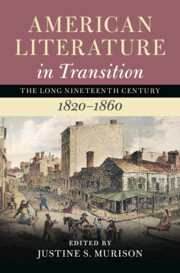Book contents
- American Literature in Transition, 1820–1860
- Nineteenth-Century American Literature in Transition
- American Literature in Transition, 1820–1860
- Copyright page
- Contents
- Figures
- Contributors
- Series Preface
- Acknowledgments
- Chapter 1 Introduction
- Part I Fractures and Continuities
- Chapter 2 Hemisphere
- Chapter 3 Empire
- Chapter 4 Economy
- Chapter 5 Religion
- Chapter 6 Nature
- Chapter 7 Removal
- Chapter 8 Abolition
- Part II Forms and Formats
- Part III Authors and Figures
- Index
Chapter 4 - Economy
from Part I - Fractures and Continuities
Published online by Cambridge University Press: 09 June 2022
- American Literature in Transition, 1820–1860
- Nineteenth-Century American Literature in Transition
- American Literature in Transition, 1820–1860
- Copyright page
- Contents
- Figures
- Contributors
- Series Preface
- Acknowledgments
- Chapter 1 Introduction
- Part I Fractures and Continuities
- Chapter 2 Hemisphere
- Chapter 3 Empire
- Chapter 4 Economy
- Chapter 5 Religion
- Chapter 6 Nature
- Chapter 7 Removal
- Chapter 8 Abolition
- Part II Forms and Formats
- Part III Authors and Figures
- Index
Summary
This essay examines how the antebellum economy was depicted in American literature from about 1820 to 1860. The first section borrows from the “New Economic Criticism” to provide an overview of the way American writers tended to represent the emergence of a new form of economic selfhood in America, one based both on credit and speculation and on market notions of “success” and “failure.” The second section takes its cue from recent scholarship in “Transnational American Studies” to suggest a possible future for economic criticism, one that attends to the way American literary selfhood was imagined during this period in relation to global networks of trade and exchange.
- Type
- Chapter
- Information
- American Literature in Transition, 1820–1860 , pp. 54 - 69Publisher: Cambridge University PressPrint publication year: 2022

